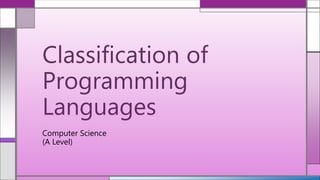Classification of Programming Languages
•
18 gefällt mir•14,243 views
Computer Science - Classification of Programming Languages Programming Languages are broken down into High level and Low level languages. This slideshow shows how they are classified and explains low level and high level languages in depth.
Melden
Teilen
Melden
Teilen

Empfohlen
Weitere ähnliche Inhalte
Was ist angesagt?
Was ist angesagt? (20)
Introduction to Software Engineering & Information Technology

Introduction to Software Engineering & Information Technology
Ähnlich wie Classification of Programming Languages
A programming language is a notation designed to connect instructions to a machine or a computer.
Programming languages are mainly used to control the performance of a machine or to express algorithms.
At present, thousands of programming languages have been implemented.
In the computer field, many languages need to be stated in an imperative form, while other programming languages utilize declarative form.
The program can be divided into two forms such as syntax and semantics. Programming Languages Categories / Programming Paradigm By: Prof. Lili Saghafi 

Programming Languages Categories / Programming Paradigm By: Prof. Lili Saghafi Professor Lili Saghafi
Ähnlich wie Classification of Programming Languages (20)
Programming Languages Categories / Programming Paradigm By: Prof. Lili Saghafi 

Programming Languages Categories / Programming Paradigm By: Prof. Lili Saghafi
Evolution of programming languages-migara presentation.pptx

Evolution of programming languages-migara presentation.pptx
Mehr von Project Student
Mehr von Project Student (20)
Appraisal (Self Assessment, Peer Assessment, 360 Degree Feedback)

Appraisal (Self Assessment, Peer Assessment, 360 Degree Feedback)
High Level Languages (Imperative, Object Orientated, Declarative)

High Level Languages (Imperative, Object Orientated, Declarative)
Motivation Theories (Maslow's Hierarchy of Needs, Taylor's Scientific Managem...

Motivation Theories (Maslow's Hierarchy of Needs, Taylor's Scientific Managem...
Operating System (Scheduling, Input and Output Management, Memory Management,...

Operating System (Scheduling, Input and Output Management, Memory Management,...
Product Life Cycle (Stages and Extension Strategies)

Product Life Cycle (Stages and Extension Strategies)
Product (Product Portfolio, Branding, USP, Product Depth and Breadth, Product...

Product (Product Portfolio, Branding, USP, Product Depth and Breadth, Product...
Training Methods (On-The-Job, Off-The-Job, Retraining and Apprenticeships)

Training Methods (On-The-Job, Off-The-Job, Retraining and Apprenticeships)
Error Checking and Correction (Parity Bit, Majority Voting, Check Digit)

Error Checking and Correction (Parity Bit, Majority Voting, Check Digit)
Workforce Planning (Process, Labour Shortage, Excess Labour)

Workforce Planning (Process, Labour Shortage, Excess Labour)
Kürzlich hochgeladen
Kürzlich hochgeladen (20)
Food safety_Challenges food safety laboratories_.pdf

Food safety_Challenges food safety laboratories_.pdf
Unit-V; Pricing (Pharma Marketing Management).pptx

Unit-V; Pricing (Pharma Marketing Management).pptx
This PowerPoint helps students to consider the concept of infinity.

This PowerPoint helps students to consider the concept of infinity.
ICT Role in 21st Century Education & its Challenges.pptx

ICT Role in 21st Century Education & its Challenges.pptx
Mixin Classes in Odoo 17 How to Extend Models Using Mixin Classes

Mixin Classes in Odoo 17 How to Extend Models Using Mixin Classes
Basic Civil Engineering first year Notes- Chapter 4 Building.pptx

Basic Civil Engineering first year Notes- Chapter 4 Building.pptx
HMCS Max Bernays Pre-Deployment Brief (May 2024).pptx

HMCS Max Bernays Pre-Deployment Brief (May 2024).pptx
Python Notes for mca i year students osmania university.docx

Python Notes for mca i year students osmania university.docx
UGC NET Paper 1 Mathematical Reasoning & Aptitude.pdf

UGC NET Paper 1 Mathematical Reasoning & Aptitude.pdf
Classification of Programming Languages
- 1. Computer Science (A Level) Classification of Programming Languages
- 2. 4th Generation Data query, analysis and reporting 3rd Generation Imperative 2nd Generation Assembly 1st Generation Machine code High level languages Low level languages Programming Languages - Generations
- 3. 2nd Generation Assembly 1st Generation Machine code Low level languages Low Level Languages (These low level languages are explained in another Slide Show)
- 4. Machine code and Assembly code A programming language that allows programs to be written using English keywords and is platform independent (Definitions)
- 5. Advantages • Achieves a smaller memory footprint (compact) • Achieves better code optimisation and therefore code will run faster and more efficiently • Allows direct manipulation if the registers on the processors, giving high levels of control • Processors in these systems may be slow and have limited memory so the efficiency of assembly language or machine code is needed. Also useful real time control systems where speed is very important • Since you are writing at machine level you control the level of of the code created. • Can be easily modified Low Level Languages
- 6. Disadvantages • More difficult to understand, maintain and debug than high level languages • More difficult to write without making errors • Machine dependent making it difficult to port to a different instruction set processor • Memory addresses and operations have to be remembered Low Level Languages
- 7. High Level Programming Languages Imperative Object Oriented Procedural Declarative Logic Database Query Functional Hierarchy of High Level Languages
- 8. • High level languages are problem-orientated whereas low level languages are machine-orientated. • Problem-orientated means that the commands and the way the program is structured are based on what the program will have to do rather than the components of the computer it will be used with. • This means that programs of high level languages are portable. These programs can be written on one computer and then executed on another. High Level Languages
- 9. • There are many types of high level languages, each is written to cope with the demands of specific types of problems. E.g. some are designed for scientific applications, manipulating databases, creating web pages etc. • There are 2 classified groups of high level languages –Imperative –Declarative High Level Languages
